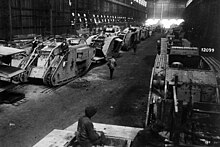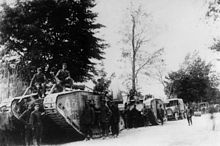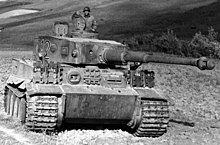Captured tanks



As Beutepanzer are called armored vehicles , mostly battle tank , which the opponents of war captured and by his own armored force was used or studied. Captured armored vehicles primarily provide important insights into the opponent's weapon technology, which is used to develop own types of tanks.
Captured tanks that were used in their own armed forces were usually provided with their own national emblem so that they were not attacked by their own or allied armed forces by self- fire, as they could be mistaken for an enemy tank due to the model. For their use, if they were captured in large numbers, user manuals for the tank crews were drawn up in order to facilitate operation. Captive tanks are used as a regular part of the armored force , provided they have military uses and the supply of ammunition , fuel and spare parts and repairs are ensured. If these are used over a longer period of time, replacing some components such as B. Armament tries to match it to its own tanks in order to simplify replenishment and repair.
First World War
During the First World War , so many British tanks (mostly Mark IV ) fell into the hands of the German armed forces that they far exceeded the number of tanks they produced themselves. Assembly camps and repair shops were set up, and tank squadrons with the captured tanks were set up. The tanks were given the Iron Cross as a national emblem and some of them were given a new camouflage finish. By the end of September 1918, a total of 170 enemy tanks had been captured in a serviceable condition. At this point, 35 of them were reported to be operational. In comparison, only 20 of the company's own A7V model were built.
Second World War
Loot vehicles played a role that should not be underestimated, especially for the Wehrmacht . Already after the annexation of Austria (March 1938) and the so-called smashing of the rest of the Czech Republic (March 1939), armored vehicles there were taken over by the Wehrmacht. In October 1940 the Army Office ordered two copies of every captured type of tank, type of vehicle, etc. to be delivered to the Motor Vehicle Testing Office of the Army Weapons Office for evaluation purposes.
In active troop service , captured tanks were used sporadically or in small groups (for example, in captured armored car platoons) on all fronts. The Africa Corps was an exception : Since the Panzer Army Africa constantly suffered from a shortage of supplies, its vehicle fleet consisted at times of up to 85 percent of captured vehicles.
In some cases, tanks were captured in large numbers. In the western campaign, 691 British main battle tanks were captured, of which around 350 could have been reusable for the Wehrmacht. However, a sufficient supply of ammunition was not guaranteed for most vehicles. In order to be able to continue using these, the chassis of prey tanks were also converted into ammunition transporters and observation tanks. Others received superstructures with weapons from their own production and thus became self-propelled guns or tank destroyers .
Vehicles that were too badly damaged were used to obtain spare parts ("cannibalized").
During the war against the Soviet Union , large numbers of BT and T-26 tanks and T-60 combat vehicles could be captured up to the turn of the year 1941/42 . In spring 1943, the occupied SS Panzer Corps , the Kharkov Tractor Plant in recaptured Kharkov and let there T-34 set -Panzer repaired. The SS Panzerjäger Department 2 of the “Das Reich” division was equipped with these, for example .
Examples of captured tanks in World War II
Use by the Wehrmacht
- Czechoslovak Škoda LT vz.35, as Panzerkampfwagen 35 (t)
- Czechoslovak ČKD-Praga TNH, as Panzerkampfwagen 38 (t) , after the occupation of the rest of the Czech Republic , more than 1,400 units were produced from 1939 to 1942
- light Czechoslovakian ČKD-Praga LT-H tanks, as Panzerkampfwagen 39 (t)
- Czechoslovak Praga T-33 - Tanketten used as armored transport vehicle and tractor
- soviet T-50
- Soviet T-35 , used under the designation Panzerkampfwagen 751 (r)
- soviet T-60
- Soviet heavy battle tank KW-1 , used as Panzerkampfwagen (PzKpfw) 756 (r)
- Soviet heavy battle tank KW-2 , as Panzerkampfwagen 754 (r) , often used by the German Wehrmacht as an artillery observation tank
- Soviet T-34 main battle tanks as PzKw 747 (r) , also converted to recovery and ammunition tanks and ambulance vehicles
- Soviet heavy battle tank IS-2 (JS-2) , e.g. B. captured in early March 1945 during the Solstice company and then used by the Wehrmacht
- Soviet reconnaissance tank BA-10 , used as armored car Ba 10 203 (r) for fighting partisans in the Balkans and in the Soviet Union
- Soviet artillery tug Comintern , used as artillery tug 604 (r)
- British Cruiser Tank Mk. I (A9) , left behind as a Panzerkampfwagen Mk.IV 744 (e) after the defeat at the Battle of Dunkirk
- Churchill assault tank during the Africa campaign
- Universal carrier , in the armed forces as chassis Bren (e) and Panzerjäger Bren 731 (e) denotes
- British Matilda II infantry tanks , as I Pz Kpfw Mk II 748 (e) , captured in the Africa campaign and also used there
- Polish 7TP light tank, u. a. thus became the 203rd tank battalion in France and Norway provided
- Polish armored car wz. 34 , used by the German police in the general government-occupied Poland
- French light tank Hotchkiss H-35 as "Panzerkampfwagen 35 H 734 (f)" and "Panzerkampfwagen 38 H 735 (f)"
- French light tank Hotchkiss H-39 as Panzerkampfwagen 39-H 735 (f) or as a tank destroyer with an anti-tank gun mounted in place of the tower, captured in Poland and France, used in the war against the Soviet Union and in the African campaign
- French Char B1 as Panzerkampfwager B2 740 (f)
- French Renault FT as armored car 17R / 18R 730 (f) for security tasks
- French Renault R-35 , as an artillery and ammunition tractor
- French Renault UE Chenillette tank transport as infantry tractor UE 630 (f)
- Italian AB43 reconnaissance tank , captured in the case of the axis (September 1943), retrofitted with MG 42 or MG 34 by the Wehrmacht
- Italian light battle tank L6 / 40 , u. a. Used to fight partisans as a flamethrower
- Italian medium battle tank M13 / 40 , used by the SS - Sturmgeschütz -Abteilung and the "Panzerabteilung Adria" as Sd.Kfz. 735 (i ) for fighting partisans
- Italian heavy battle tank P26 / 40 , used as armored car P40 737 (i)
- Italian assault gun Semovente 75/18 , as assault gun M42 (i)
- Italian assault gun Semovente 105/25 ( Bassotto = Dachshund), as assault gun M43 (i)
- Italian assault gun and tank destroyer Semovente 90/53 , taken over after the Italian surrender and used as long-range artillery
- Artillery tug Saurer RR-7 , taken over by the Austrian Armed Forces after the annexation of Austria and used as a reconnaissance vehicle (official name: "armored observation vehicle" )
- American half-track M3 , captured during the Africa campaign , later on the Western Front and in Italy
- American medium tank M4 Sherman , as armored car M4 748 (a) , captured during the Africa campaign, western and eastern fronts and in Italy
Use by the Red Army
- German assault gun III
- Panzerkampfwagen V Panther , under the name of T-5 or TV Pantera
- Panzerkampfwagen IV as T-4 or T-IV , were used with German national emblems for infiltration purposes
- Panzerkampfwagen III , as T-3 or T-III
- Panzerkampfwagen 38 (t) , as LT-38 or Praga
- Panzerkampfwagen I , as T-1 or TI
Used by the Finnish Army in the Continuation War
- Soviet fast moving tank of the BT series , captured in the Soviet-Finnish war
- soviet T-26
- Soviet BT-7 of the 1937 series
Use by the Romanian Army
- Soviet light floating tank T-40
Used by the Allies on the Western Front
- Italian M13 / 40 battle tanks, called Dingo, Wombat or Rabbit by the Australian 6th Cavalry Regiment, which were marked with white kangaroos on the hull and tower
Examples of captured tanks after World War II
- Soviet T-72 battle tanks, stolen from regular army depots by both parties in the Nagorno-Karabakh conflict
- American M47 (Patton I) main battle tank captured by the Cypriot National Guard after the Turkish invasion of Cyprus in August 1974
- American M48 main battle tank, abandoned in Vietnam by the Americans after the US Army withdrew
- The Israeli army captured large quantities of T-55 and T-54 in the Arab-Israeli wars and used them as Tiran and Achzarit (armored personnel carriers / transport tanks).
See also
literature
Topic First World War:
- Fred Koch: captured tanks in the First World War - British, French and Russian combat and armored vehicles in the German army. Podzun-Pallas Verlag, 1994, ISBN 3-7909-0520-8 .
Topic Second World War:
- Alexander Lüdeke: Wehrmacht loot tanks. Type compass. Motorbuch-Verlag, 2011:
- Wehrmacht loot tanks 1938–1945: Austria, Czechoslovakia, Poland, the Netherlands, Belgium and France. ISBN 978-3-613-03291-0 .
- Wehrmacht captured tanks: Great Britain, Soviet Union and USA 1939–1945: Great Britain, Soviet Union and USA 1939–1945. ISBN 978-3-613-03359-7 .
- Werner Regenberg, Horst Scheibert: Looted tanks under the Balkenkreuz. Podzun-Pallas Verlag, 1990, ISBN 3-7909-0392-2 . (also: Dörfler-Verlag, 2003, 3-89555-105-8)
- Walter J. Spielberger: Loot vehicles and tanks of the German armed forces. Military vehicles, Volume 12. Motorbuch Verlag, 1989, ISBN 3-613-01255-3 .
- Werner Regenberg: Booty tanks under the Balkenkreuz / American and English battle tanks. Waffen-Arsenal Volume 137. Podzun-Pallas-Verlag, 1992, ISBN 3-7909-0448-1 .
Web links
Individual evidence
- ↑ Wolfgang Fleischer: Armored Firepower , Podzun-Pallas Verlag, 2004, ISBN 3-7909-0779-0 .
- ↑ Russian captured tanks , second-weltkrieg-lexikon.de ( Memento from February 12, 2013 in the web archive archive.today )
- ↑ Char B1 / B1 bis - Tank Encyclopedia. Retrieved July 31, 2018 (American English).


